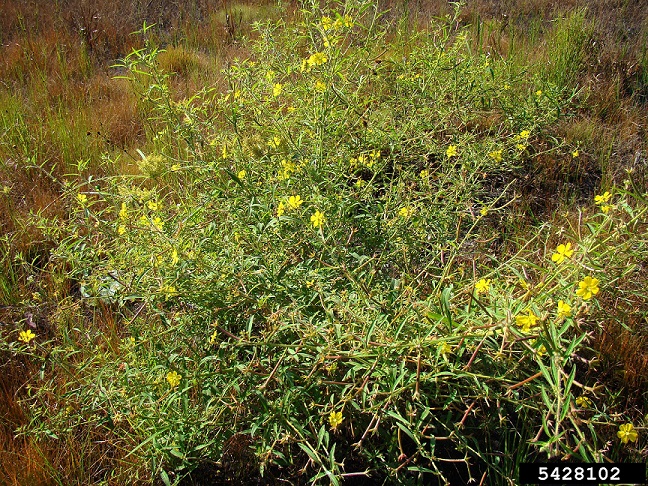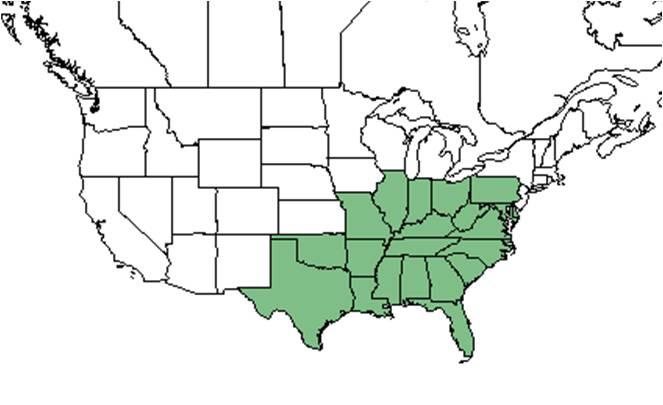Difference between revisions of "Ludwigia leptocarpa"
(→References and notes) |
KatieMccoy (talk | contribs) (→Taxonomic notes) |
||
| Line 20: | Line 20: | ||
Common name: Anglestem primrose-willow | Common name: Anglestem primrose-willow | ||
==Taxonomic notes== | ==Taxonomic notes== | ||
| + | The specific epithet ''L. leptocarpa'' means slender-fruited<ref name="eol">[[http://eol.org/pages/582918/details]] Encyclopedia of Life Accessed: February 6, 2016</ref>. | ||
| + | |||
==Description== | ==Description== | ||
<!-- Basic life history facts such as annual/perrenial, monoecious/dioecious, root morphology, seed type, etc. --> | <!-- Basic life history facts such as annual/perrenial, monoecious/dioecious, root morphology, seed type, etc. --> | ||
Revision as of 18:54, 5 February 2016
| Ludwigia leptocarpa | |
|---|---|

| |
| Photo by Rebekah D. Wallace, University of Georgia, Bugwood.org | |
| Scientific classification | |
| Kingdom: | Plantae |
| Division: | Magnoliophyta - Flowering plants |
| Class: | Magnoliopsida – Dicotyledons |
| Order: | Myrtales |
| Family: | Onagraceae |
| Genus: | Ludwigia |
| Species: | L. leptocarpa |
| Binomial name | |
| Ludwigia leptocarpa (Nutt.) H. Hara | |

| |
| Natural range of Ludwigia leptocarpa from USDA NRCS Plants Database. | |
Common name: Anglestem primrose-willow
Contents
Taxonomic notes
The specific epithet L. leptocarpa means slender-fruited[1].
Description
“Repent or erect, usually branched, short-lived perennials, or rarely annual. Floral parts in 4-7’s; hypanthium not prolonged beyond ovary. Capsules longitudinally or poricidally multiseriate, rarely uniseriate. Most of the erect species produce basal offshoots, which have ovate to obovate leaves, in the late summer and fall. Bracteoles occur in pairs on the pedicel or stipe or on the base of the hypanthium.” – Radford et al 1964
"Stems erect, branched, pubescent, to 1 m tall. Leaves alternate, elliptic, pubescent, to 12 cm long and 3 cm wide; sessile or subsessile. Sepals 5-7, lanceolate, pubescent, 4.5-7 mm long, 2-3 mm wide; petals 5-7, 5.5-7.5 mm long, 4-8 mm wide. Capsules cylindric, 2-5 cm long, 2-3.5 mm in diam.; bracteoles subulate, ca. 0.5 mm long; pedicels absent or to 2 cm long; seeds uniseriate, free inside brownish endocarp." - Radford et al 1964
Distribution
Ecology
Habitat
In the Coastal Plain in Florida, L. leptocarpa can occur along lake margins, uppear beach near edge of slash pine woodlands, around cypress ponds, wet ditches bordering swamps, drainage ditches bordering pine flatwoods, wet slough, inter-dune ponds, and growing on decaying vegetation. It has been observed growing in disturbed areas such as roadways and Kudzu dominated seepage areas (FSU Herbarium). Soil types include sandy loam, loamy sand, sandy soil, peaty sand, and sandy peat (FSU Herbarium). Associated species include L. decurrens and L. sphaerocarpa (FSU Herbarium).
Phenology
Flowering occurs May through November and fruiting July through November (FSU Herbarium).
Seed dispersal
Seed bank and germination
Fire ecology
Pollination
The following Hymenoptera families and species were observed visiting flowers of Ludwigia leptocarpa at Archbold Biological Station (Deyrup 2015):
Apidae: Apis mellifera, Bombus impatiens
Vespidae: Polistes fuscatus
Use by animals
Diseases and parasites
Conservation and Management
Cultivation and restoration
Photo Gallery
Flowers of Ludwigia leptocarpa Photo by Rebekah D. Wallace, University of Georgia, Bugwood.org
References and notes
Deyrup, M.A. and N.D. 2015. Database of observations of Hymenoptera visitations to flowers of plants on Archbold Biological Station, Florida, USA.
Florida State University Robert K. Godfrey Herbarium database. URL: http://herbarium.bio.fsu.edu. Last accessed: October 2015. Collectors: Loran C. Anderson, K. Craddock Burks, George R. Cooley, A.H. Curtiss, Richard J. Eaton, William B. Fox, J.P. Gillespie, Robert K. Godfrey, Gary R. Knight, R. Komarek, R. Kral, Karen MacClendon, Travis MacClendon, Richard S. Mitchell, R.A. Norris, James D. Ray Jr., Annie Schmidt. States and Counties: Florida: Bay, Calhoun, Duval, Franklin, Gadsden, Hernando, Hillsborough, Jackson, Jefferson, Leon, Liberty, Madison, Okaloosa, Putnam, Santa Rosa, Taylor, Wakulla, Walton. Compiled by Tall Timbers Research Station and Land Conservancy.
Radford, Albert E., Harry E. Ahles, and C. Ritchie Bell. Manual of the Vascular Flora of the Carolinas. 1964, 1968. The University of North Carolina Press. 744-5. Print.
